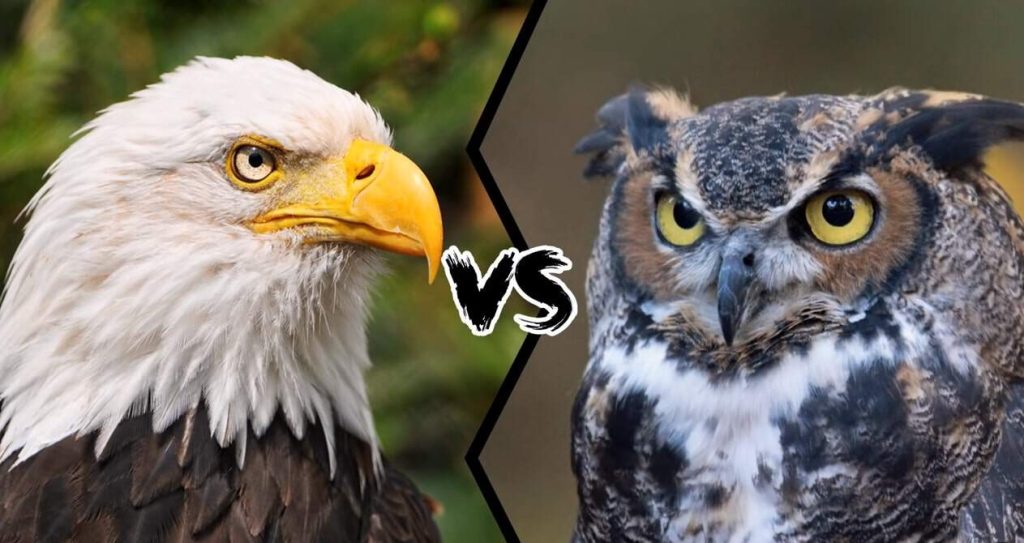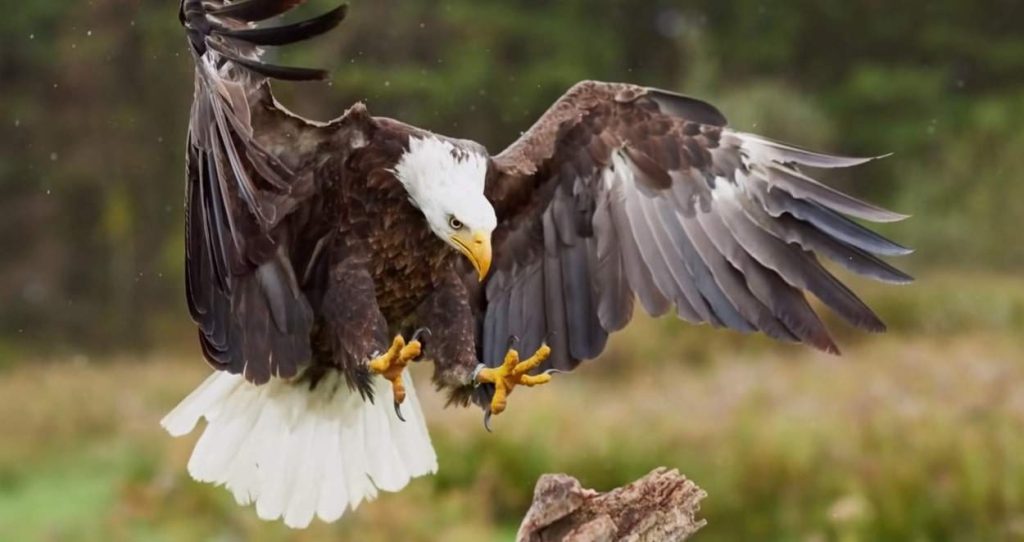Soaring, sailing, whizzing through the sky, it looks fun, right? But you would want to be the predator more than the prey.
The lion may be the King of the jungle (or the Savannah, if we’re being factually accurate), but the skies are home to two very different predators—hunters of the sky, land, and sea: the eagle and the Owl.
Two beautiful birds of tremendous cunning and strength, varying in size and color; their mastery of the skies is rarely challenged by other birds.
But when we put these two birds side-by-side, how do they differ, and, if they were to meet in the gladiator ring, which one would come out on top to earn the crown of King of the Skies?
Well, read on to find out as I take you into the feathered world of our flying friends (let’s hope they’re our friends.)
Wingspan
Where shall we begin? I know! Let’s start with the most important component of flying: the wings.
Owls and eagles, of course, come in all shapes and sizes, from the small to the very big. Take the elf owl, which has a wingspan of 9 inches. This may seem small, but the Blakiston’s fish owl swoops in with a wingspan reaching up to 78 inches!
Eagles, on the other hand, also vary. But even the little eagle beats the smallest owl with a wingspan of 47 inches. And then we get to the big ones – you’ve all heard of the bald eagle, I’m sure – with a wingspan that can amount to a huge 90 inches.
But get this: in 1931, it was recorded that a Wedge-tailed eagle had a ginormous 111-inch wingspan! Now, that’s a bird I don’t want to make an enemy of.
Size

With wingspans varying as much as that, the actual size of these birds must, too, right? Of course. Remember that little elf owl I mentioned?
Well, these cute little things can range between a tiny 4.9 and 5.7 inches. But then we get the Blakiston Fish owl, which likes to show off, coming in at a much larger 28 inches.
Now, let’s see how the eagles compare. The little eagle can peak at 21.5 inches and weigh around 1.8lb, which puts the little elf owl to shame. But let’s move on to those gorgeous big beasts.
The golden eagle, one of the largest birds in North America, can reach a huge 33.1 inches and weigh 13.2 lb—no wonder they look so ferocious.
Active Time
As you probably know, many owls are nocturnal, meaning they come out at night. Their waking hours are usually when we are fast asleep unless we’re still in our partying phase.
There are a few, though diurnal (meaning they are active during the day), such as the little owl and short-eared owl. But most of the time, these wise old creatures venture out under the moon’s watchful eye.
Eagles are very much daytime birds. The clearness of the day is when they venture out and hunt best. Bald Eagles may leave their roost around 8 am and return a few hours before dusk.
And, don’t expect to see many on overcast days—the eagle likes those clear, blue-skied days (much like us) where its prey is much clearer to its eyes.
Beak Length
To eat, these beautiful creatures need a good beak to break through to that much-needed food. Looking at some of the larger variations, the great horned owl’s beak can come in at 2 inches; similarly, so can the snow owl that lives in those cold arctic regions.
For the most part, eagles have larger beaks, too—bald eagles can have a beak measuring up to 2.69 inches, and Steller’s sea eagles come in even higher at 2.84 inches. Now, you wouldn’t want those nibbling at your hand.
Speed
When out-catching your prey, speed is a vital component. These birds can’t just take a trolley into the local supermarket.
For owls, they have to be very quick to catch any fleeing prey. The great horned owl, when casually flying, still goes at an impressive 30mph.
But, once its eyes lock onto that enticing piece of food, 30mph quickly becomes 40mph. I wouldn’t like to be running from that.
Then we have the eagles. If you thought 40mph was impressive, think again. When diving after their prey, the bald eagle can reach around 100mph.
And, if your mouth hasn’t dropped to the floor, let me introduce you to the golden eagle. This beautiful creature can dive at a speed of up to 200mph! Yes, you read that right! Their prey stands no chance!
Feathers
Both these gorgeous species look so beautiful because of their stunning feathers. But these feathers also serve a very important purpose.
If you were to find a feather on the floor with quite a wide and round shape (less pointy,) then this would probably be an owl’s feather.
If you inspect it closer, you might see this feather is cloaked in a soft, velvety covering of smaller feathers. This, along with the roundness, minimizes sound as they fly through the air looking for prey.
Eagle feathers are much longer and pointier. They go through many stages, usually being born with white fluffy feathers, which molt and grow into pin feathers with a blood supply to help them grow.
Once the eagle has matured, it molts yearly, its feathers constantly renewing, enabling it to have the best control over its flying.
No wonder they can reach such frightening speeds.
Diet

We all need food, right? But you probably won’t be lining up to taste the owl’s and eagle’s meals, unless you like your food raw. Sushi, anyone?
The owl’s diet varies from each species. Scops and screech owls tend to feed on insects or spiders, whereas the barn owl likes to go for a meatier dish of mice, shrews, or voles. Neither of which I particularly fancy.
Eagles also vary. But, the bald eagle loves a bite of fish, so it must be so fast to catch them. But the diet doesn’t end there.
Small birds, ducks, and if they’re flying over grassland, small mammals such as rabbits or mice are also not safe from those sharp talons.
FAQs
Who would win in a fight, the owls or the eagles?
This is a hard fight to gauge. Because they come in such varying sizes, there is no conclusive way of telling. A bald eagle would have no problem against the smaller species of owls. The huge talons of bald and golden eagles, their sharp beaks, and frightening speed are hard to match.
A great-horned owl would be a worthy opponent. These owls are very similar in size to the largest eagle. It comes down to circumstances and the animal’s ferocity. For my money, the speed at which a golden eagle can fly surely gives it a superior advantage.
Who has better eyesight?
It all depends on the day. During the day, no other animal can match the eagle. On a clear day, an eagle can spot its prey from a sensational two miles away.
But less clear days can cause a problem, and once the night comes, the owl shows itself as the master of the dark. With a higher density of light-sensitive cells, at night they can spot larger prey from a mile away.
Do eagles fear owls?
Many eagles have reason to fear the owl. The owl’s silence means in the stillness of the night, as the bald eagle sleeps next to their eggs or nestlings, owls have been known to see these offspring as potential prey. You’d be quite scared if you knew something was after your children!
Final Thoughts
So, there we go! What a ride through the winged world of these intelligent and ferocious predators. Their beauty and grandeur don’t just come from their looks but from their smarts and cunning.
The owl shows itself to be mostly a master hunter of the night, with its piercing eyes, rotating heads, and silent flying, creating a striking predator. But the eagle is just as mighty (if not more so), graceful in the sky, able to reach incredible speeds and see for miles.
Who would win? No one knows. It all comes down to circumstance. The eagle may be faster, but the owl has many advantages, too.
Let’s be grateful that these beautiful creatures grace our skies and hope we never become targets for their sharp talons!

